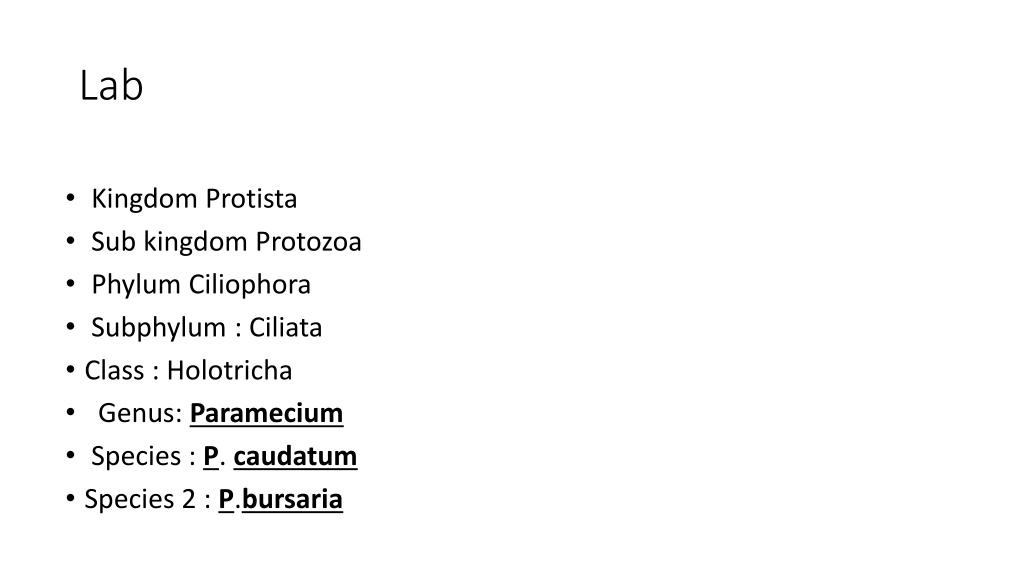
Insight into Paramecium: A Ciliate Protozoan
Paramecium, a ciliate protozoan, is prevalent in freshwater environments and displays unique biological characteristics, such as a slipper-shaped body with two nuclei, a vital role of cilia in locomotion and feeding, and asexual reproduction through binary fission. Paramecium species like P. bursaria also exhibit symbiotic relationships with green algae, showcasing mutual benefits. Through binary fission and conjugation, Paramecium demonstrates fascinating reproductive strategies crucial for its survival.
Download Presentation

Please find below an Image/Link to download the presentation.
The content on the website is provided AS IS for your information and personal use only. It may not be sold, licensed, or shared on other websites without obtaining consent from the author. If you encounter any issues during the download, it is possible that the publisher has removed the file from their server.
You are allowed to download the files provided on this website for personal or commercial use, subject to the condition that they are used lawfully. All files are the property of their respective owners.
The content on the website is provided AS IS for your information and personal use only. It may not be sold, licensed, or shared on other websites without obtaining consent from the author.
E N D
Presentation Transcript
Lab Kingdom Protista Sub kingdom Protozoa Phylum Ciliophora Subphylum : Ciliata Class : Holotricha Genus: Paramecium Species : P. caudatum Species 2 : P.bursaria
Paramecium is prevalent in freshwater , though some species can thrive in marine environment. Paramecium is a slipper - shaped and have two nuclei ( a large macronucleus and a single compact micronucleus ) . They cannot survive without the macronucleus and cannot reproduce without the micronucleus . Like all ciliates, the cilia plays a crucial role in the overall functioning of a paramecium body . While in water , groups of cilia orient in a particular direction , allowing the cell to propel forward or backward . The oral groove (cytostome or peristome ) is lined by compound cilia , which help in drawing foods inside the cell . Basically , paramecium feeds on bacteria , yeast and small algae . Thus , cilia serve as locomotory and feeding part of this unicellular organism .
paramecium reproduce asexually , by binary fission . During reproduction , the macronucleus splits by a type of mitosis , and the micronuclei undergo mitosis . The cell then divides transversally , and each new cell obtains a copy of the micronucleus and the macronucleus , and it's reproduce sexually , by conjugation , During conjugation , the micronuclei of each conjugant divide by meiosis and the haploid gametes pass from one individual to the other . The gametes of ench organism then fuse to form diploid micronuclei . The old macronuclei are destroyed , and new ones are developed from the new micronuclei .
Paramecium bursaria is a species of ciliate protozoan that has a mutualistic symbiotic relationship with green algae called Zoochlorella . The algae live inside the Paramecium in its cytoplasm provide it with food , while the Paramecium provides the algae with movement and protection . P. bursaria is 80-150 um long , with a wide oral groove , two contractile vacuoles , and a single micronucleus as well as a single macronucleus . P bursaria is the only species of Paramecium that forms symbiotic relationships with algae , and it is often used in biology classrooms both as an example of a protozoan and also as an example of symbiosis .
Paramecium caudatum is 120-330 um long . The cell body is roughly cigar shaped , rounded at the front , tapering at the posterior to a blunt point . The pellicle is uniformly covered with cilia , and has a long oral groove , leading to deeply embedded oral cavity , lined with cilin . P. caudatum has two star - shape contractile vacuoles , and a cell envelope ( cortex ) densely studded with spindle - shaped extrusomes called trichocysts . The species is very common , and widespread in marine , brackish and freshwater environments.
Species : Balantidium coli: is the largest protozoa parasite inhabit in the large intestine of man caused Balantidiasis . It has two stage in their life cycle : 1- Trophozoite stage : Oval in shape , the anterior end is pointed and has groove leading to a mouth ( cytostome ) . The posterior end is broadly rounded and has an excretory opening known as cytopyge . The cytoplasm has : a - two nuclei , a macronucleus which is large and present in the middle of the body, It may kidney shaped and curved . The micronucleus is a small round and lies in close to the macronucleus . b - two contractile vacuoles which may lie side by side or one above the other e - food vacuoles which have food particles such as bacteria , starch granules . RBC , .... ect . The body covered with delicate pellicle embedded with it short cilia .
Cyst stage : Spherical or oval surrounded by a thick double - layered wall . In the mature cyst the cilia are absorbed , macronucleus micronucleus , and vacuoles are present in the cyst . Pathogenicity : Most infection with B.coli are harmless Rarely the trophpzoites invade the mucosa and submucosa of the large intestine and produce ulcers or abscesses extend to the muscular layer . The ulcer round and covered with pus and necrotic material Diagnosis : G.S.E.
